The Princess and the Dragon
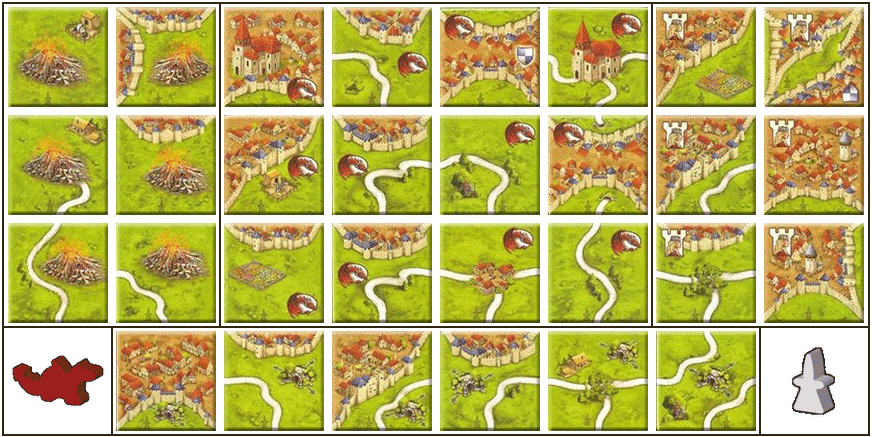
All in all, this expansion introduces you to the world of fantasy, the land
of fairy tales and where knights fight big dragons with the following new
features:
| 6 Volcano tiles |
12 Dragon tiles |
6 Princess tiles |
6 Magic Portal tiles |
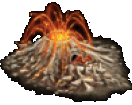 |
 |
 |
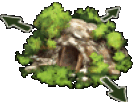 |
| The Dragon appears |
The Dragon moves |
A knight leaves the city |
A meeple appears |
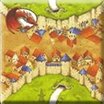 Tunnel: The two road segments that
proceed through the tunnel are part of a single connected road. The lower
field is not interrupted, and the upper field is not interrupted either. Tunnel: The two road segments that
proceed through the tunnel are part of a single connected road. The lower
field is not interrupted, and the upper field is not interrupted either.
 Monastery in a city: If you choose
to place a meeple on this tile, you must choose whether to place it in the
city, on the monastery, or in the field. If you wish, you may lay the meeple
down on the monastery to differentiate a monk from a knight within the city.
The monastery is complete when it is surrounded by tiles, even if the city is
still under construction. You may place a monk on this monastery when knights
are already present in the city. Likewise, a monk placed on this monastery
does not prevent a player from placing a knight in the same city. Monastery in a city: If you choose
to place a meeple on this tile, you must choose whether to place it in the
city, on the monastery, or in the field. If you wish, you may lay the meeple
down on the monastery to differentiate a monk from a knight within the city.
The monastery is complete when it is surrounded by tiles, even if the city is
still under construction. You may place a monk on this monastery when knights
are already present in the city. Likewise, a monk placed on this monastery
does not prevent a player from placing a knight in the same city.
English Rules
At the beginning of the game, set the Dragon and fairy meeples
to the side – they do not belong to any player.
The Dragon

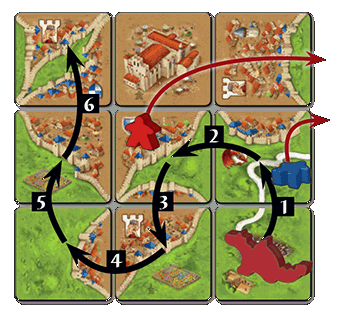 Whenever
a Volcano tile is placed, the Dragon is moved to that tile.
Whenever a Dragon tile is placed, the players take turns moving
the dragon 6 spaces
(vertically or horizontally) where the dragon eats
all of the meeples on each tile. The Dragon does eat Farmers that are
only on one tile, but does not eat Barns which are on the
intersection of 4 tiles, and it does not eat a meeple in a Castle
which is on the intersection of 2 tiles!
Whenever
a Volcano tile is placed, the Dragon is moved to that tile.
Whenever a Dragon tile is placed, the players take turns moving
the dragon 6 spaces
(vertically or horizontally) where the dragon eats
all of the meeples on each tile. The Dragon does eat Farmers that are
only on one tile, but does not eat Barns which are on the
intersection of 4 tiles, and it does not eat a meeple in a Castle
which is on the intersection of 2 tiles!
The Dragon then waits on the last tile until another Volcano
or Dragon tile is played.
Note: The rules say that if a Dragon tile is drawn before the
first Volcano tile is drawn, since the Dragon is not on the
board yet, return the Dragon tile randomly back into the tile stack.
Since we each have separate stacks, this could be a problem for us, we would
know which stack might have an extra Dragon! Since each Dragon
tile also has other playable features on it, my thoughts are that we should
just place the tile as usual and ignore the Dragon!
The Fairy
 The fairy is a
neutral figure that belongs to no player. It begins the game in the supply. The fairy is a
neutral figure that belongs to no player. It begins the game in the supply.
On any turn in which you do not place (or move) a meeple, including
the placement of a volcano tile, you may assign the fairy to one of your
meeples by placing the fairy directly next to it.
When the fairy is standing next to one of your meeples, it can help that
meeple in 3 different ways:
- If the fairy is still assigned to one of your meeples at the start of
your next turn, you immediately score 1 point.
- The dragon may not move to a tile occupied by the fairy. All figures on
the fairy's tile are protected from the dragon's hunger.
- When scoring a feature (city, road, monastery, field, etc.) where the
fairy is assigned to one of your meeples, you score 3 points, regardless
of whether or not you score points for the scored feature. Your meeple
returns to your supply, as normal, but the fairy remains on its tile.
Every move in the game of Carcassonne happens in 3 phases:
1. Place a tile,
2. Place a meeple and
3. Score a feature
The printed rules for the Expansion 3: The Princess and the Dragon
clearly defines the movement of the Dragon as phase 1b. If you
draw a Dragon tile:
- 1. You place your tile.
- 1b. The dragon moves and eats the meeples on 6 tiles.
- 2. You place a meeple or move the Fairy.
- 3. You score any completed features.
Under the standard rules, each player's decision to not place a
meeple on their turn so they can move the Fairy to protect one
of their meeples from the Dragon was a strategic decision.
For some unknown reason, the WikiCarPedia website decided to change
moving the dragon from phase 1b to phase 2b which changes the order
of play to: If you draw a Dragon tile
- 1. You place your tile.
- 2. You place a meeple or move the Fairy.
- 2b. The dragon moves and eats the meeples on 6 tiles.
- 3. You score any completed features.
Under the modified rules, the Fairy strategy is hardly worth
consideration because the player who draws the Dragon tile has full
control of where the Fairy is before the Dragon moves.
We made forum posts on both the Carcassonne Central and Board Game Geek
forums to try to find out the official rules, and the responses were all
over the place, so here are the rules that we will follow for our game
nights.
The Order of Play from WikiCarPedia says:
Step 1A: Begin Turn
There are no particular actions for this step.
Step 1B: Draw a Tile
- Randomly draw a tile.
- Show the tile to all players.
Step 1C: Place the Tile
- Place the tile. If the placement is illegal, you must discard the
tile and go back to Step 1B.
- Note: any tile-based feature that is finished is considered complete
at this time.
And the 2016 English printed rules for Expansion 3 includes the lable

If the movement of the Dragon happens within Step 1B: Draw a Tile no
one can take any advantage of the movement. It is literally happening
randomly between the moves of two players. The player who actually drew the
tile doesn't even get to Step 1C: Place the Tile until after the
Dragon has moved. The ONLY advantage that the player who draws the
Dragon Tile has is that they will make the first move of the Dragon which
they can use to move away from their meeples or towards the meeples of
their opponents!
This will leave the strategy of when does a player sacrifice placing a
meeple for the advantage of moving the Fairy to either protect one of their
own features or un-protect one of the other player's features completely
untouched. Some of the posts on both forums wanted the player who draws the
Dragon Tile to move the Fairy before the Dragon moves, which completely
undermines that strategy.
So bottom line, on our game nights the Dragon will move as soon as a player
looks at the drawn dragon tile and before they place it on the board! After
the Dragon Moves, the tile will be placed as if it were just a normal
tile!
- - OR - -
That was a reasonable interpretation of how the current printed rules could
be interpreted. But there was a lot of talk on the forums about C1 vs
so I started looking for any mention of what the rules were back in 2005
when expansion 3 was originally released. Here is a website that gives a
reasonable interpretation of those original rules:
href=https://www.goblins.net/files/downloads/S-CAR_v6.4.pdf
The Dragon
A player who places a dragon tile may deploy a follower or move the fairy
as usual. 127 128 Then (before scoring) the game is interrupted
129 - the dragon is on the move!
127. This is a clarification, in accordance with the FAQ. The original rules
made no mention of the fairy. The dragon tile may be placed, no follower
deployed, and the fairy moved to protect a follower, before the dragon
actually moves.
128. Question: If you place a dragon tile and add a piece to a tower,
what happens first: follower capture by the tower, or dragon movement?
Answer: Prisoners are taken first; placing a tower piece is an
alternative to deploying a follower, so occurs before dragon movement.
129. The RGG edition contradicts the sequence described in the HiG edition
and the FAQ: “If placement of the tile completes a feature, it is scored as
normal. Then, the game is briefly interrupted while the Dragon moves.” So,
according to the RGG edition of the Big Box, dragon movement occurs after
scoring; according to HiG it occurs before scoring. The ZMG edition follows
the HiG rule and specifically adds that the interruption is
“before scoring.” (5/2013)
OK Basically the movement of the dragon was also done between
turns back in 2005, but it was done AFTER the player who drew the
Dragon completed their entire turn, including scoring a feature!
Our game night group will have to make the decision: 3 tiles are drawn by 3
different players, DO WE: A move the Dragon as soon as the
Dragon Tile is drawn and continue with the Fairy
as a relatively important feature in the game - OR - B
give all of the power to the person who draws the dragon tile which basically
eliminates the strategy of the Fairy?
The Princess

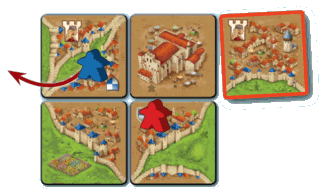 Princess tiles are placed exactly like those in the base game. If a Princess
tile continues a city occupied by one or more knights, you may remove one
knight of your choice (even your own) from the continued city and return it
to its player's supply.
Princess tiles are placed exactly like those in the base game. If a Princess
tile continues a city occupied by one or more knights, you may remove one
knight of your choice (even your own) from the continued city and return it
to its player's supply.
If you chose to remove a meeple, you may not place a meeple
this turn (not even on a different segment of the tile). If you did not
remove a meeple, you may place a meeple as normal.
The Magic Portal
 After placing a Magic Portal tile in the usual manner, you may place a meeple
on that tile or on any other previous placed tile. When doing so,
must follow all other placement rules. For example, you may not place a
meeple in an already occupied or completed feature. Note: you may not
place a meeple on a feature that the magic portal tile has completed!
After placing a Magic Portal tile in the usual manner, you may place a meeple
on that tile or on any other previous placed tile. When doing so,
must follow all other placement rules. For example, you may not place a
meeple in an already occupied or completed feature. Note: you may not
place a meeple on a feature that the magic portal tile has completed!
This tile is pure Magic! You can use a meeple, abbot, large meeple,
mayor, wagon, etc. to claim any City, Road, Monastery, Garden, Farm, etc.
on the entire board as long as it is unoccupied and incomplete.
|